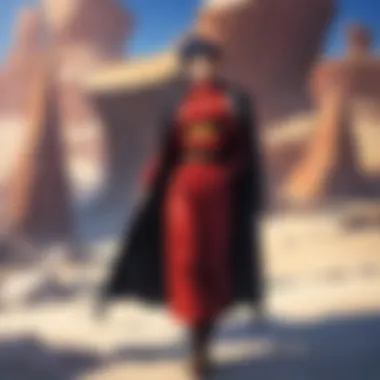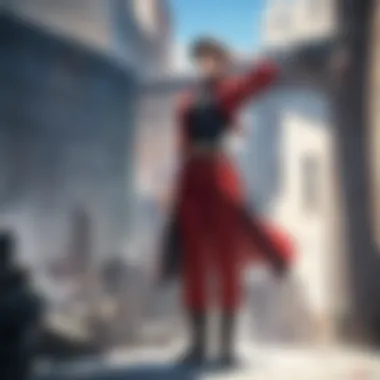Exploring Trigun: Free Streaming and Anime Culture


Intro
The exploration of Trigun serves not only as an analysis of a captivating narrative but also as a lens through which we can understand the shifting landscape of anime consumption. In the context of free streaming services, Trigun exemplifies how digital access has changed the dynamics of viewership. This article will dissect key elements of the series, emphasizing its significance in anime culture. We will look closely at the major themes, character arcs, and the artistic choices that define Trigun. Furthermore, we will discuss how free streaming options have influenced viewer engagement and broadened anime's international reach.
Series Overview
Synopsis and Premise
Trigun follows the journey of Vash the Stampede, a gunslinger with a notorious reputation. His mission is to navigate a desolate world while promoting peace and love, in stark contrast to his fearsome title. The series is set in a post-apocalyptic landscape where resources are scarce and lawlessness prevails. As the plot unfolds, viewers encounter various factions and characters, all of whom challenge Vash's ideals and complicate his quest for redemption.
Notable Characters
- Vash the Stampede: The protagonist, characterized by his whimsical demeanor and deep-rooted convictions.
- Nicholas D. Wolfwood: A traveling priest who carries a large cross-shaped weapon, embodying the moral ambiguities of the series.
- Meryl Stryfe: A member of the Bernardelli Insurance Society who initially seeks to contain Vash but becomes one of his staunch supporters.
These characters are fleshed out through their interactions with Vash, presenting viewers with moral dilemmas and ethical challenges that resonate throughout the series.
Themes and Motifs
Major Themes Explored
Trigun delves into several crucial themes:
- Pacifism vs. Violence: Vash’s struggle to uphold peace while facing violent confrontations illustrates this ongoing conflict.
- Redemption: Many characters seek redemption for past sins, highlighting the human capacity for change.
- Existential Questions: The narrative often challenges characters and viewers alike to ponder the value of life and the nature of existence.
Symbolism in Storytelling
The series employs symbolism extensively, using Vash’s signature red coat as a metaphor for sacrifice and struggle. Additionally, the recurring motif of guns represents both protection and the potential for destruction, adding layers to character motivations and the overall message.
Artistic Style and Animation
Visual Aesthetics and Design
Trigun is known for its distinctive visual style that balances western aesthetics with anime influences. Character designs exhibit a blend of exaggerated features and realistic details. This unique approach enhances the series’ narrative depth, inviting viewers into its stylized world.
Animation Techniques and Trends
The animation techniques used in Trigun effectively capture the emotional nuances of the characters. Fluid movement during action sequences contrasts with the more static imagery in reflective moments. This dynamic animation style has influenced other anime series, showcasing the innovation present in Trigun.
"Trigun is more than just a story of action and adventure; it is a profound exploration of the human experience, embodied in every encounter and conflict."
As we progress through this article, we will further investigate the impact of free streaming services on Trigun's accessibility and the ongoing evolution in the anime viewing landscape.
Intro to Trigun
The Introduction to Trigun serves as a foundational pillar within the broader exploration of this iconic anime series. Understanding Trigun’s unique narrative and thematic compositions sets the stage for appreciating its impact in anime culture, particularly in relation to the rise of free streaming platforms. Not only does this section outline the series, but it also provides necessary context for much deeper discussions to follow.
Overview of the Series
Trigun is a popular anime adapted from Yasuhiro Nightow's manga. It premiered in 1998 and quickly gained a devoted following due to its distinctive blend of science fiction and western elements. The story follows Vash the Stampede, a gunslinger with a mysterious past. He travels through a desolate desert landscape, often embroiled in conflict due to his immense bounty and naiveté about human nature.
The series is characterized by its engaging characters, thrilling gunplay, and profound philosophical inquiries. Vash poses as a carefree figure, all while grappling with the weight of his past actions, all while being pursued by various foes. With dynamic storytelling and character arcs, Trigun captivates viewers long after the credits roll.
This analysis illuminates critical aspects that define Trigun, setting up discussions around its visual storytelling techniques and thematic richness in subsequent sections.
Significance in Anime History
Trigun holds a notable position in anime history, influencing many subsequent works. Its unique combination of genres and storytelling methods facilitated new narrative possibilities in anime. The character of Vash defies the traditional hero archetype by embodying both lightheartedness and depth of emotion, captivating audiences worldwide.
In 1998, anime was becoming more mainstream outside Japan, and Trigun’s release coincided with an increasing Western interest in the medium. As a result, it played a pivotal role in introducing a more diverse audience to anime, paving the way for others like Cowboy Bebop and Fullmetal Alchemist. Its thematic exploration of morality, redemption, and the human condition resonates with viewers, extending its relevance even in today's digital age.


In examining Trigun, the objective is to unfold its intricate layers and contextualize its manner in which free streaming alters not just the consumption of anime, but the culture surrounding it.
Understanding Free Streaming Services
The exploration of free streaming services plays a crucial role in this article. Understanding these services helps to contextualize how Trigun and similar animes are consumed in today's digital landscape. Free streaming services have transformed the accessibility of anime, allowing fans and newcomers alike to engage without financial barriers. This access has potential implications for creator revenues, the spread of anime culture, and ultimately the sustainability of the medium.
Definition and Scope
Free streaming services refer to platforms that allow users to watch content without paying for a subscription or purchase. These services typically monetize their operations through advertising, requiring users to view sponsorships or ad breaks during their viewing experience.
In the context of anime, free streaming services can vary widely: some offer a vast library of genres while others focus on specific types like Trigun. It's important to understand that while these platforms provide access, they may also raise concerns over content legality and ethical considerations. Users often encounter unclear licensing agreements that can impact how and where anime is accessible.
Popular Platforms Offering Trigun
Several platforms have emerged that facilitate streaming of Trigun at no cost to the user. Here are a few notable ones:
- Crunchyroll: Primarily a subscription service, they also provide a range of free titles supported by ads.
- Tubi: This service boasts a vast selection of content that can be streamed for free, including classics and lesser-known titles.
- Funimation: Offers some of its anime catalog free with ads, though access to certain features may require payment.
Accessing Trigun through these platforms increases its visibility, but the implications of streaming anime freely come with both positive and negative aspects.
Themes in Trigun
The exploration of themes within Trigun serves as a critical lens through which viewers can appreciate both the storytelling and the socio-cultural commentary embedded in the series. Themes such as philosophical undertones, morality, ethics, and the nature of violence not only enrich the narrative but also engage the audience to reflect on larger societal issues. This section examines these themes, illustrating their significance and impact on the overall viewing experience.
Philosophical Undertones
Trigun delves into various philosophical questions that challenge the audience to think deeply about existence, purpose, and choice. The character of Vash the Stampede embodies these philosophical quandaries. His quest for peace juxtaposed with his violent world raises questions about determinism versus free will.
The series frequently poses the inquiry: can one maintain their ideals in an inherently corrupt society? This pushes viewers to contemplate their own beliefs and actions. By navigating through despair and hope, the philosophical undertones in Trigun shape not only its narrative but also its characters. The existential dilemmas faced resonate with a wider audience, eliciting introspection regarding individual actions and societal virtues.
"Trigun invites us to consider how much of our identity is shaped by the choices we make amid chaos."
Morality and Ethics
Morality in Trigun is multifaceted, embodying shades of gray rather than clear-cut binaries. The series presents conflicting moralities, particularly reflected in Vash and Nicholas D. Wolfwood. Vash advocates for non-violence, even as he confronts relentless threats. Conversely, Wolfwood represents a more pragmatic viewpoint, suggesting that sometimes harm is necessary for the greater good.
This moral complexity invites viewers to engage in discussions about right and wrong, often illustrating that decisions are rarely without consequence. The ethical debates surrounding actions, intentions, and outcomes underscore the narrative, making Trigun not just a sci-fi western but a discourse on morality in a troubled world. This moral ambiguity is crucial due to its ability to resonate with the audience’s own ethical dilemmas and uncertainties.
Nature of Violence
The depiction of violence in Trigun is artfully nuanced. Rather than glorifying it, the series critically examines the repercussions and motivations behind violent actions. The frequent clashes highlight not just the physical destruction but the emotional and psychological toll on the characters involved. Vash's reluctance to kill exemplifies a stark contrast to the violent world he inhabits.
This theme serves as a commentary on the broader implications of violence in society, challenging the viewer to reflect on the cycle of aggression and its effects on humanity. Consequently, Trigun invites its audience to reevaluate the portrayal of violence in media, recognizing its potential to perpetuate cycles of hatred or to foster understanding. This critical engagement with violence makes it a substantial theme within the series, which resonates with contemporary issues surrounding aggression and conflict in society.
By delving into these complex themes, Trigun opens up layers of understanding, enriching the viewer's experience while spotlighting important socio-cultural conversations.
Character Development in Trigun
Character development in Trigun serves as a fundamental pillar of the narrative. It goes beyond surface-level portrayals, delving deeply into the psychology of its characters. Understanding these developments enriches the viewing experience, revealing how each character contributes to the overall themes of the series. This section will explore the intricate arcs of key characters, highlighting how their growth reflects broader philosophical questions and the series’ moral complexities.
Vash the Stampede: A Complex Hero
Vash the Stampede stands out as a character rich in complexity. He embodies the archetype of the reluctant hero, often displaying a jovial personality that masks deeper struggles. His ability to navigate his own pacifism amidst a world fueled by violence is crucial. Vash grapples with his violent past, which is heavily tied to the moral lessons he strives to embody in his present.
His journey is not just about evading conflict but also about understanding the consequences of his choices. Through these experiences, viewers witness Vash confronting his fears and battling inner demons. This internal conflict is particularly highlighted in his relationships with other characters, notably his interactions with Wolfwood. These exchanges serve as both catalysts for Vash’s growth and reminders of the heavy burden he carries. Vash’s development challenges viewers to reconsider the traditional notions of heroism, juxtaposing strength with vulnerability.
Wolfwood: The Antihero's Arc
Nicholas D. Wolfwood presents a contrasting, yet complementary, figure to Vash. As an antihero, Wolfwood embodies ambiguity; his profession as a priest working with guns complicates moral perceptions in the narrative. His character is a study in duality, struggling between duty and personal beliefs. This tension is particularly clear in his justification for violence, highlighting the personal sacrifices he makes.


Wolfwood’s arc is not solely about choosing sides; instead, he faces constant moral dilemmas that force him to question his own ethics. This complexity makes his eventual fate poignant, as it not only affects his character but also catalyzes crucial developments in Vash’s journey. By examining Wolfwood, viewers can glean insights into the consequences of moral compromise and the search for redemption within a chaotic world.
The Role of Female Characters
Female characters in Trigun play pivotal roles that enrich the narrative landscape. They are not merely supplementary figures; instead, characters like Milly and Meryl embody resilience and strength. Milly, often seen as cheerful and naive, provides a counterbalance to the darker themes portrayed in the series. Her unwavering faith in Vash and hope for humanity highlight the emotional stakes involved in their journey.
Meryl, on the other hand, offers a more nuanced portrayal of strength and vulnerability, often acting as a foil to Vash’s ideals. Through her development, the series explores the complexities of agency and choice, as she transitions from an observer to an active participant in Vash’s life.
The portrayal of female characters challenges traditional gender roles, allowing them to assert influence within a male-dominated narrative. Their interactions with other characters deepen the plot, ensuring that the series does not fall into one-dimensional portrayals.
"Character development drives Trigun, making audiences think twice about the themes presented."
In summary, the character development in Trigun invites viewers to reflect on moral ambiguity, the nature of heroism, and the transformative power of personal choices. Through Vash, Wolfwood, and the female characters, the series crafts a profound commentary on the human experience that resonates well beyond its animesque aesthetic.
Visual Storytelling Techniques
Visual storytelling techniques are crucial to understanding how Trigun crafts its narrative and engages the audience. The series uses imagery effectively to convey emotions and themes, making it more than just a visual spectacle. This is particularly important in an anime landscape where visuals can often overshadow the story. By analyzing the techniques used in Trigun, viewers can appreciate the layered storytelling that complements its rich character arcs and complex themes.
Art Style and Animation
The art style of Trigun is distinctive and serves a vital role in establishing its unique identity. The character designs reflect their personalities, which enhances viewers' understanding of their motivations and backgrounds. Vash the Stampede, for instance, is designed with a playful yet rugged appearance, embodying his mix of humor and tragedy. The vibrant colors used throughout the series contrast with the often bleak landscapes, emphasizing the duality of hope and despair.
Animation quality significantly contributes to the storytelling. The fluid movement during action sequences provides a sense of urgency, while slower paced scenes allow for emotional depth. Events are not just shown; they are felt, and the animation invites the viewer to experience this emotional landscape.
Moreover, key visual motifs appear throughout the series. Items like the red coat and the cross-shaped gun are emblematic, weaving into the storytelling. They hold narrative weight and stay with the viewer long after the episode ends.
Cinematography and Scene Composition
Cinematography in Trigun enhances the narrative and emotional engagement. The use of varied camera angles shapes how scenes are perceived. Close-ups effectively capture the characters' emotional states, while wide shots establish the isolation often experienced in a desolate world. Such techniques help to communicate the vast emptiness of the environment, mirroring the characters’ internal struggles.
Scene composition plays an important role in pacing and impact. For example, framing Vash in the center during key moments signifies his role as the story's moral compass. By consciously arranging elements within the frame, the direction creates an atmosphere that complements the action and dialogue.
The Impact of Free Streaming on Anime Consumption
Free streaming services have transformed the way audiences engage with anime. This shift affects not only viewer habits but also the distribution and accessibility of shows like Trigun. The democratization of anime consumption through free streaming platforms presents significant implications for both creators and audiences alike.
Changing Viewer Habits
The advent of free streaming services has changed how viewers access anime. Traditional viewing methods often required cable subscriptions or purchasing DVDs. Now, websites such as Crunchyroll and Funimation make it simple to watch Trigun without the need for payment.
This shift has led to a more casual approach to viewing. New audiences, eager to explore different anime titles, can watch with minimal investment. As a result, binge-watching has become a norm instead of waiting for weekly episodes. This change in consumption habits is pertinent for series like Trigun, where deeper exploration of themes may be overshadowed by the need for immediate satisfaction in viewing.
Access and Accessibility
Access to anime has dramatically increased due to free streaming platforms. Viewers from various regions gain the opportunity to engage with anime content that was previously inaccessible. Trigun, as a classic series, benefits from this broadened accessibility.
Not only are viewers able to watch different shows, but they benefit from bio-linguistic features like subtitles, which help non-native speakers understand the content. The increased availability of dubbed versions and subtitles promotes inclusivity.
- Global reach: Free streaming allows fans from different cultures to experience anime, expanding its audience.
- Subtitles and dubs: Viewers can choose their preferred language, enhancing understanding.
However, this convenience comes with caveats. The quality of subtitles can vary across platforms, leading to potential misinterpretations of cultural nuances.
Cultural Exchange and Influence
Free streaming has fostered cultural exchange. Nowadays, anyone can access Trigun, which possesses strong Western influences mixed with traditional Japanese storytelling. As diverse viewers engage with Trigun, they share their insights and reactions with peers across social media platforms such as Reddit or Facebook.
This exchange of ideas enriches the understanding of Trigun and anime in general. Enthusiasts may discuss its philosophical themes and moral dilemmas. Such conversations drive deeper connections between fans and encourage the exploration of related series.
"Anime serves as a medium for cultural exchange, revealing the interconnectedness of global audiences."


Legal Implications of Free Streaming
The legal ramifications of free streaming are essential for understanding how this medium operates within the broader framework of media consumption. With the growing popularity of platforms that allow users to access shows like Trigun for free, it is vital to delve into copyright issues and ethical considerations that arise. This exploration not only affects content creators and platforms but also the viewers who partake in this accessible format.
Copyright Issues
Copyright concerns are at the forefront of discussions regarding free streaming services. Anime such as Trigun falls under the protection of intellectual property laws, which grant creators exclusive rights to reproduce, distribute, and display their work. Unauthorized streaming may infringe these rights, leading to potential legal actions from copyright holders.
This creates a delicate balance between accessibility and legality. Viewers must understand that, while platforms may offer free content, the legality of such offerings can be questionable. Instances of litigation against sites that host pirated anime are not uncommon. For example, platforms like KissAnime faced legal challenges, highlighting the risks inherent in consuming content from unverified sources.
"Streaming services change the consumption landscape but tread on delicate legal ground—it's crucial to be informed."
Consequently, audiences seeking to enjoy Trigun and similar shows should consider official avenues that respect copyright, ensuring that creators are supported for their work.
Ethical Considerations
Beyond legality, ethical concerns also merit attention. The availability of free streaming raises questions about the sustainability of anime production. When viewers access content without compensating creators, it can lead to funding challenges for future projects. This places immense pressure on studios to generate revenue, often affecting the quality of content produced.
Moreover, free streaming contributes to a culture that undervalues artistic creation. If audiences widely accept free access as the norm, they may inadvertently diminish the perceived worth of anime as an art form. Viewers should reflect on the consequences of their choices and consider supporting licensed distributors, whether through subscriptions or purchasing physical media.
In summary, understanding the legal and ethical implications of free streaming is crucial for anime enthusiasts. Engaging with shows like Trigun should come with an awareness of how one's viewing habits impact both the industry and the creators behind the stories.
Future of Trigun in Streaming Media
As the landscape of anime consumption evolves, understanding the future of Trigun in streaming media is crucial. Streaming services have changed how viewers access content. They have dismantled geographic barriers that traditionally restricted audiences. This transformation can influence the revival and adaptation of classic series like Trigun and can spark discussions on how anime, as a genre, adapts to new platforms.
Potential Revivals and Spin-offs
Trigun's narrative depth and cult following create opportunities for revivals or spin-offs. Its unique blend of Western motifs and philosophical themes makes it ripe for reinterpretation in new formats. Several streaming platforms may find value in creating new series or films based on its established universe. Fan interest continues to manifest in community discussions, with platforms like Reddit buzzing with theories and desires for continuation.
- Merchandising Opportunities:
- Expanded Universe:
- Collaboration with Renowned Creators:
- Merchandising tied to potential revivals can attract both old and new fans.
- Promotions around new merchandise can rekindle interest in the original series.
- Spin-offs could explore uncharted storylines or character backstories.
- A deeper dive into side characters could cement Trigun’s legacy in a modern context.
- New adaptations can benefit from collaborations with respected creators in the anime industry.
- Attracting known voices can enhance storytelling and artistic direction.
The Role of Streaming in Anime’s Evolution
Streaming has played a pivotal role in shaping anime’s evolution. It provided a platform for lesser-known titles to gain massive audiences. For Trigun, this platform not only supplies accessibility but also helps sustain its relevance. As anime fans increasingly gravitate towards streaming, the genre has shifted from niche to mainstream.
- Global Audience Reach:
- Thrive of Original Content:
- User-Driven Content:
- Streaming services make it easier for international audiences to access Trigun and similar series.
- Overcoming localization challenges has enabled broader cultural appreciation.
- Increased demand for original content has prompted studios to invest in new stories while revisiting classics.
- The success of originals changes perceptions of older titles, leading to possible revivals.
- The rise of user-generated content around anime has given fans a voice.
- Online communities can drive interest in revisiting series like Trigun, influencing streaming strategies.
"Streaming has moved anime from the shadows of niche markets to the forefront of mainstream entertainment, allowing classics like Trigun to find new life in the digital age."
Finale
In the context of this article, the conclusion serves as a crucial synthesis of the various elements discussed regarding Trigun and its evolving relationship with free streaming services. Understanding these connections is vital for anyone keen on anime culture, as they reflect broader shifts within media consumption.
Summary of Key Points
The exploration of Trigun has revealed several significant themes and observations:
- Continued Relevance: Trigun remains a noteworthy title in the anime canon. Its complex characters and philosophical undertones contribute significantly to discussions about morality and ethics in storytelling.
- Impact of Free Streaming Services: The article looked into how free streaming dramatically affects viewer habits and accessibility. Such platforms have made series like Trigun widely available, contributing to its enduring popularity and cultural reach.
- Legal and Ethical Considerations: The implications of free streaming go beyond viewer convenience. Issues related to copyright and ethical viewing have been highlighted as integral to the ongoing discussions about this medium.
- Future Prospects: Insights into potential revivals and spin-offs indicate an evolving landscape for not just Trigun, but for anime as a whole. Streaming services have a key role in this transformation.
Final Thoughts on Trigun and Streaming
Anime enthusiasts can appreciate Trigun’s depth while also navigating the ever-evolving streaming landscape. \nIt's essential to remain informed about these changes, as they shape both contemporary viewing habits and the legacy of iconic series. Watchers should embrace the digital age with an awareness of the complex interplay of culture, ethics, and technology that defines our current media ecosystem.

